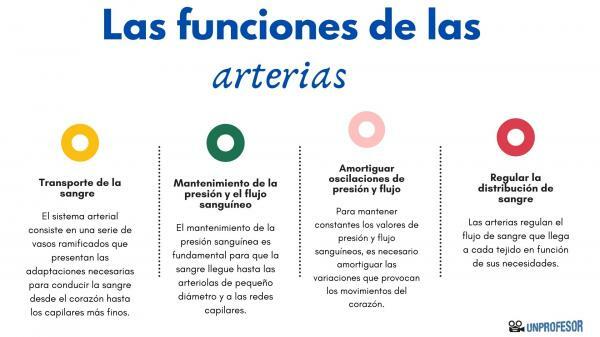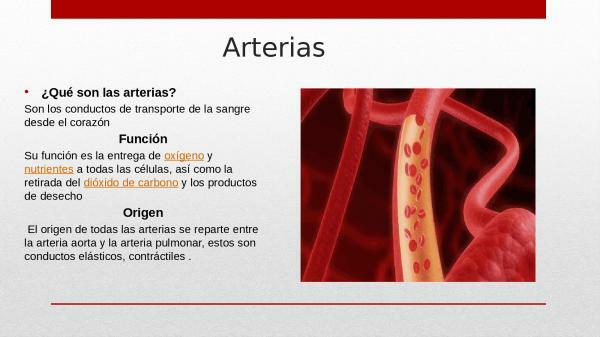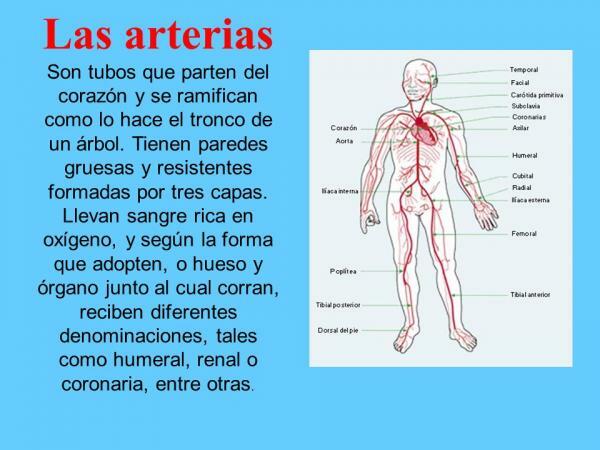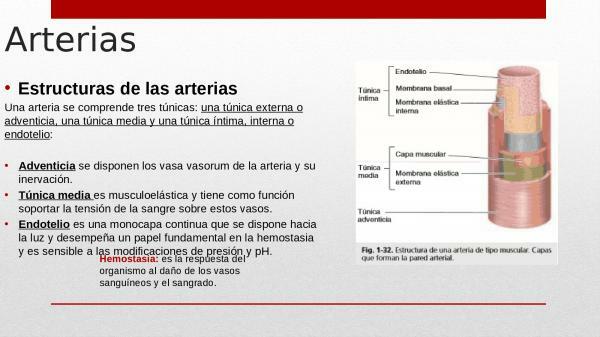Function of ARTERIES in the human body

The arteries are blood vessels responsible for the blood circulation which is pumped by the ventricles of the heart, to the periphery of the body or to the lungs. However, these are not mere conduits, the arteries look very little like simple pipes; rather, they take an active part in developing key functions to ensure the proper functioning of the body. In this lesson from a TEACHER you will see in detail what the function of the arteries and the different regulatory mechanisms in which they are involved.
Index
- 4 functions of the arteries
- Main function of the arteries: blood transport
- Maintaining pressure and blood flow
- Dampen pressure and flow oscillations generated by the heart
- Regulate blood distribution
4 functions of the arteries.
The arteries are part of circulatory system and perform four functions main:
- Act as conduit for transportation of blood between the heart and capillaries.
- Act as pressure reservoir to force the passage of blood into small-diameter arterioles.
- Dampen the pressure and flow variations produced by the heart to ensure a continuous flow at constant pressure in the capillaries,
- Regulate blood distributionto the different capillary networks through a selective vasoconstriction of the terminal branches of the arterial tree.
In the following sections we will see in more detail each of these functions and what are the characteristics of these vessels that allow them to be performed.
Main function of the arteries: blood transport.
This is the most obvious function of the arteries. The arterial system consists of a series of branching vessels that present the necessary adaptations to drive blood from the heart to the finest capillaries, which are the vessels that carry blood through the tissues. The transport function of the arteries is related to the characteristics of their walls. These are made up of different layers that change as the arteries decrease in diameter and move away from the heart. Thus, we find walls with an elastic middle layer in the great arteries, while a middle layer formed by muscle tissue predominates in the median arteries.
The transport of blood from the heart begins when the calls of the large arteries or elastic arteries, which are also called conduction arteries; they receive the blood pumped from the ventricles of the heart at high pressure. From these arteries, blood passes to the medium or muscular arteries, which are also called distribution arteries.
From the distribution arteries the blood passes to the arterioles (arteries of small diameter) from where they will reach the capillary networks where the blood exchanges gases and other substances with the cells of the tissues.
This exchange is totally different in the two circulatory systems of the body:
- Systemic arterial circulation: in this case, the main function of the arteries is the transport of oxygen, linked to the red blood cells, from the heart to all the organs and tissues of the body.
- Pulmonary arterial circulation: Instead, the pulmonary artery carries low-oxygen, high-CO2 blood to the lungs to remove CO2 from the lungs.
- The ability to transport blood from the arteries is closely related to their structure. The cape or middle tunic of the arteries, is composed of smooth muscle tissue, which is combined with elastic fibers. Thanks to the presence of muscle tissue, the arteries can change their diameter, reducing it to push the blood towards the periphery of the body or by increasing it to reduce blood pressure if it is excessive, to prevent the arteries from break.

Image: Docsity
Maintenance of pressure and blood flow.
Maintaining blood pressure is another function of the arteries and is essential for blood reaches the arterioles small diameter and capillary networks.
The elasticity and muscular layer of the arteries decrease with increasing distance from the heart. For this reason, the great arteries o elastic arteries, have a fundamental role in maintaining blood pressure values, since they receive blood from the heart at high pressures, which dampen thanks to its elasticity.
The arteries muscles and arterioles, with a tunica media composed of muscle cells, responsible for maintaining this constant pressure until the arrival of arterial blood to the capillary networks. In this way, blood pressure is kept within values that guarantee the arrival of arterial blood to all body tissues at all times.

Dampen pressure and flow oscillations generated by the heart.
This function of the arteries is closely related to the previous one. Since, to keep the blood pressure and flow values constant, it is necessary to dampen the variations that cause the movements of the heart.
When the ventricles of the heart contract, expel blood at high pressures and blood flow is increased. In contrast, when the ventricles relax, pressure and blood flow decrease. If these changes produced by each heart beat are not smoothed out, maintenance would not be possible. constant pressure and blood flow to ensure proper system operation cardiovascular.
Blood pressure and blood flow are kept constant, thanks to highly precise control mechanisms, in which calls play a fundamental role. elastic arteries.
The dilation of the arteries elastic by increasing pressure and blood flow, when the ventricles contract from the heart. While, the contraction of these occurs when the flow and pressure decrease as the ventricles relax from the heart. In this way, blood flow and pressure are kept constant in the peripheral arteries.

Image: Docsity
Regulate blood distribution.
Arteries regulate blood flow that reaches each fabric according to its needs. This role corresponds mainly to the arterioles, where it produces vasoconstriction in those tissues that are not very active and vasodilation in those arteries that supply the tissues with the highest activity at a given time, as occurs, for example, in the case of muscle tissue during exercise.
The vasoconstriction or vasodilation of the arteries are controlled by the endothelium, the innermost layer of blood vessels. The cells of the endothelium of the arteries respond to an increase in blood pressure by synthesizing vasodilator substances that flow out of the vessel causing relaxation of the muscle cells of the tunica media of the arteries, which increases the diameter of the vessel and reduces blood pressure.
If you want to read more articles similar to Artery function, we recommend that you enter our category of biology.
Bibliography
- Hershel Raff, Michael Levitzky (2013). Medical physiology. An apparatus and systems approach. Madrid: McGraw-Hill Interamericana de España S.L.
- Marta Palomo, Enric Carreras, Maribel Díaz Ricart (2015) The endothelium, a key organ. Physiology. Research and science. Barcelona: Scientific Press S.L
